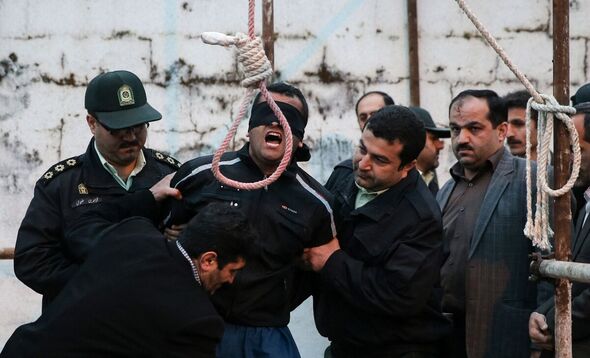Iran is executing “unprecedented” numbers of its own people with state-sanctioned killings every two hours, according to reports.
There were at least 1,000 executions last year, including 34 women and seven young people, according to the National Council of Resistance of Iran (NCRI).
It reports that Tehran started the new year with a fresh wave of killings, with 12 people hanged on New Year’s Day alone.
But the real number is reported to be “significantly” higher by NCRI, which said 2024’s figure marks a 16% increase on 2023’s 864 executions.
Behzad Naziri, a former political prisoner who escaped one of Iran’s most notorious prisons, told The Sun the “unprecedented surge” in executions is a “sign of the weakness of a regime on the verge of being overthrown”.
A member of the NCRI’s foreign committee, he said the unprecedented number of executions indicates the regime is indeed becoming increasingly paranoid.
Mr Naziri, whose sister was executed, added: “These actions are a desperate attempt by Khamenei to suppress any dissent and maintain control amid growing unrest and demands for regime change.”
The same publication reports that Iran was responsible for more than three quarters of all executions in the world last year and the regime carried out an execution every 150 minutes in 2024. Express.co.uk has not been able to independently verify those figures.
A total of 695 executions happened from July onwards after Masoud Pezeshkian became president, according to NCRI, which said 502 of the 1,000 executions resulted from drug-related charges.
One hundred and nineteen Baluchis were also executed as Tehran continued to oppress the marginalised group. Amnesty International has documented mass arbitrary arrests, forced disappearances, torture and severe beatings against Iran’s Baluchi minority.
Killings surged in the last three months of 2024 as Iran lashed out amid social and economic crises. While some 1,000 Iranians were executed, scores of others suffered barbaric punishments.
NCRI reported a prisoner being sentenced to having their eyes gouged out in retaliation for allegedly blinding a state security officer during an uprising in 2017. Other prison inmates have had fingers chopped off, according to the NCRI.
Maryam Rajavi, President-elect of the NCRI, said the “brutal” wave of executions in 2024, especially in the autumn, is Supreme Leader Ali Khamenei’s desperate attempt to prevent an uprising of an angry populace who will settle for nothing less than the regime’s complete overthrow.
She said Tehran’s medieval crimes have in fact doubled the resolve of Iran’s youth to topple the religious dictatorship.
Mrs Rajavi added: “Khamenei resorts to these executions to suppress the people’s uprising demanding the regime’s overthrow. However, these atrocities only strengthened the determination of Iran’s youth to overthrow the religious dictatorship.
“The regime must be ostracised by the international community and any dealings with it should be conditioned on halting executions and torture. Its leaders must be held accountable before justice.”
Oslo-based rights group, Iran Human Rights (IHR), reported on Monday (January 6) that 31 women were executed last year.
The group said many women executed for murder had acted out of desperation after suffering violence, rape or coercive control.
IHR Director, Mahmood Amiry-Moghaddam, said: “The execution of women in Iran reveals not just the brutality of the death penalty, but the depth of systemic gender inequality in the judicial system.”
The Iranian regime has used executions in a bid to keep Iranians in fear and to maintain its position in power since the country’s revolution in 1979, according to IHR.
US-based, Abdorrahman Boroumand Center for Human Rights, also noted a steep rise in executions in Iran last year, but reported that at least 930 state-sanctioned deaths had been carried.
The figure compares to 811 in 2023 and 579 in 2022 reported by the rights group.
